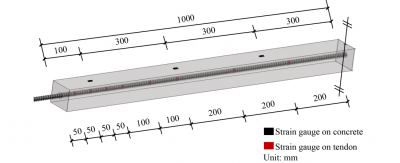Science
Researchers Examine Frost Heaving in Prestressed Concrete Structures

Recent research highlights the significant challenges posed by freeze-thaw (FT) damage in prestressed concrete (PC) structures, especially in cold regions. The study, conducted by Xiguang Liu from Xi’an University of Architecture and Technology and colleagues from Beijing YJK Building Software Co., Ltd., investigates the frost heaving behavior and mechanical deterioration of bonded post-tensioned PC components when exposed to FT cycles.
The research addresses a critical gap in understanding how FT cycles can lead to serious structural issues, such as frost heaving and cracking. These problems can ultimately compromise the safety and durability of PC structures. The study examined how varying stress levels and the number of FT cycles impact the strain characteristics of prestressing tendons.
Experimental Approach and Key Findings
The team designed and fabricated eight bonded post-tensioned PC components subjected to a series of FT cycles, specifically 0, 50, 100, 150, 200, 250, and 300 cycles, at varying stress levels of 0.1, 0.2, 0.3, and 0.4. Throughout the experiment, they meticulously measured strain variations along the components as they underwent FT exposure.
Results indicated a clear correlation between the number of FT cycles and the increase in concrete frost heaving strain, residual strain, and prestressing tendon strain loss. The study revealed that at lower stress levels, prestress can help mitigate concrete frost cracking. Conversely, as stress levels increase, the risk of frost cracking intensifies.
To better understand these phenomena, the researchers established a strain loss model that aligns closely with their experimental findings. This model provides crucial insights for the design and maintenance of PC structures in cold climates, offering a framework for engineers and architects working in these challenging environments.
Implications for Future Construction
The findings from this study are particularly relevant as the application of PC structures continues to grow in cold regions. The research underscores the importance of considering frost heaving behavior and mechanical deterioration in design specifications. By doing so, engineers can enhance the longevity and safety of these structures, ultimately benefiting infrastructure development in colder climates.
The comprehensive study titled “Frost heaving behavior and mechanical deterioration of prestressed concrete” offers valuable theoretical and experimental insights. For those interested in the detailed methodology and outcomes, the full text is available at https://doi.org/10.1007/s11709-025-1188-1.
-

 Technology5 months ago
Technology5 months agoDiscover the Top 10 Calorie Counting Apps of 2025
-

 Health2 months ago
Health2 months agoBella Hadid Shares Health Update After Treatment for Lyme Disease
-

 Health3 months ago
Health3 months agoErin Bates Shares Recovery Update Following Sepsis Complications
-

 Technology4 months ago
Technology4 months agoDiscover How to Reverse Image Search Using ChatGPT Effortlessly
-

 Technology1 month ago
Technology1 month agoDiscover 2025’s Top GPUs for Exceptional 4K Gaming Performance
-

 Technology2 months ago
Technology2 months agoElectric Moto Influencer Surronster Arrested in Tijuana
-

 Technology5 months ago
Technology5 months agoMeta Initiates $60B AI Data Center Expansion, Starting in Ohio
-

 Technology5 months ago
Technology5 months agoRecovering a Suspended TikTok Account: A Step-by-Step Guide
-

 Health4 months ago
Health4 months agoTested: Rab Firewall Mountain Jacket Survives Harsh Conditions
-

 Lifestyle5 months ago
Lifestyle5 months agoBelton Family Reunites After Daughter Survives Hill Country Floods
-

 Technology4 months ago
Technology4 months agoHarmonic Launches AI Chatbot App to Transform Mathematical Reasoning
-

 Technology3 months ago
Technology3 months agoUncovering the Top Five Most Challenging Motorcycles to Ride













